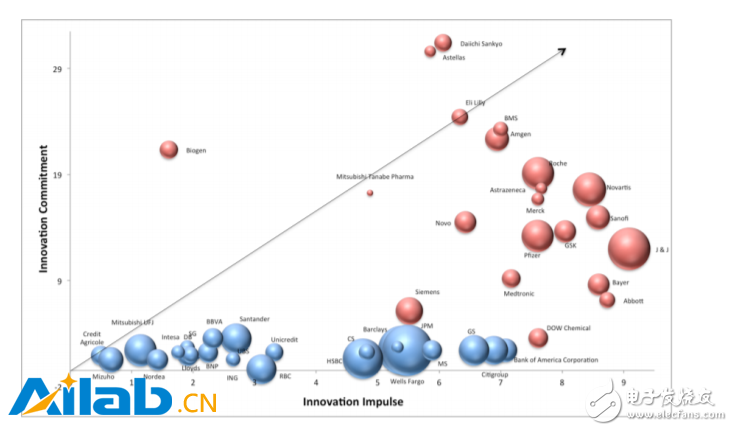Looking back at history, you will find that the financial industry is the most difficult to achieve change. But inevitably, big banks and startups have made huge breakthroughs in the financial industry. I don’t think this is because they use any special technology, but because of their inherent cultural differences, diverse structural rigidity and Other cost-effective business models. In other words, banks are not innovative because they are too large to adapt quickly and follow external incentives, or because they don't know how (or want) real change. Not only in the financial industry, but also in academia, until the mid-1990s, there was no breakthrough in financial innovation. In fact, in a small number of surveys (Cohen and Levin, 1989; Cohen, 1995), more than 600 different articles and books were cited, but none were related to financial innovation. Of course, things have changed in the past five years, but I think this change is passive, not voluntary from the banking industry. Therefore, financial innovation seems to be usually introduced by the outside rather than internally, and often more of product innovation than process innovation (although I think this view is more controversial). Given the new paradigm of technology (intensifying the inherent strong causal relationship between innovation and growth), it seems natural to wonder if a better innovation model can be introduced by different industries. I find a very special and interesting example where the industry must “innovate and survive†rather than “innovative growthâ€: that is the biopharmaceutical industry (Baker, 2003; Gans and Stern, 2004; Fuchs and Krauss, 2003; Lichtenthaler, 2008). The biopharmaceutical industry is not a single industry, but includes two different technology areas: biotechnology, consisting of small companies that drive research and exploration; and pharmaceutical companies that have grown in size in the last century. Listing and selling companies. So part of it is pure (high-risk) innovation, and the other part is pure commercialization skills...this is something we have seen, isn't it? The biopharmaceutical industry and the financial industry have formed a significant polarization The biopharmaceutical industry is characterized by the fact that the risk is primarily in the initial development process, not in the marketing phase. The problem is not to meet the needs of the customer, nor to find a market for your product, but to develop the drug molecule first. The probability of success is very low, the timeline is long (10-15 years), and the 20-year patent is only a short-lived advantage. More importantly, only about two-thirds of the drugs can offset development costs, and most companies are losing money, while the top 3% of companies account for almost 80% of the industry's profits, which is a tough one. Business. The biopharmaceutical industry is no longer just a human-intensive industry, but an industry that requires a lot of capital. Innovation is not an add-on, but the cornerstone of the survival and development of an enterprise. That's why they have to identify a range of different ways to promote their growth – innovation: R&D, competitive partnerships, venture capital, joint venture creation, acquisition deals, limited partnership agreements, and more. So far, my goal should be clear: the financial industry has not felt the same innovation needs as the biopharmaceutical industry, and it has not tried and promoted the creation of new models to maximize benefits. Now you may still think "innovation is great, but finance and biopharmaceuticals are very different industries." So why should I insist on introducing innovative models from other industries? Well, this is the problem: I am not Think they are different. And the reason they are becoming more and more similar is precisely artificial intelligence. Artificial intelligence is injecting a powerful innovation into the financial industry. It has a development cycle and characteristics, similar to the situation in the biopharmaceutical industry: it takes a long time to be created, implemented and properly deployed (of course, The standards of the financial industry are consistent; it is highly technical and requires highly specialized talent; it is highly uncertain, because before you find a viable solution, you need to conduct a lot of experimentation, artificial intelligence is being given to the financial industry. Bringing tremendous innovation pressure. But artificial intelligence is also bringing new development speed and credibility to the financial industry, reducing similar errors in the biopharmaceutical industry. This is very easy if your algorithm points out the problem product or the recommended error book. If your system incorrectly interprets certain signals in the market, or if you make a mistake while developing a drug, you will lose millions of dollars in a few seconds and even lose your life. Therefore, it extends not only issues that are essentially financial, such as regulation or accountability, but also new issues such as biased data or lack of transparency (especially in consumer applications). Finally, artificial intelligence raises a question for “building vs. purchasesâ€, which is even larger than the biopharmaceutical industry of the 1990s, reaching its peak in the current biotechnology pharmaceutical dichotomy (if you want to know, this one The focus is on your data capacity, the scalability of your team and projects, and the uniqueness of your competitor-related projects – do you have enough data to train an ANI? Is your team/project size enough? Is the ANI unique? Do your companions do something?) Artificial intelligence is revolutionizing an old industry innovation that has been around for hundreds of years. That's why I think the introduction of artificial intelligence in the financial services industry is very important – not so much about the specific innovations or products it launches, because it is revolutionizing an industry innovation process that has been around for hundreds of years. Artificial intelligence is leveraging structured and unstructured data in financial services to improve customer experience and customer engagement. In this way, we find outliers and anomalies, increase revenue, reduce costs, find predictable patterns, and improve Predictive reliability...but in other industries, is this the case? This answer is obvious, then, in the financial services industry, what is special about artificial intelligence? First, the financial industry is an industry that requires a lot of data. You might think that this data is mainly concentrated in the hands of large financial institutions, but most of the data is public, and with the new EU Payment Order (PSD2), larger databases can also be used by smaller companies. Artificial intelligence is easy to develop and apply because its barrier to entry is relatively low compared to other industries. Second, many underlying processes can be automated relatively easily, while many other processes can be improved by step-by-step calculations or speed. Historically, artificial intelligence is one of the industries that most need this kind of innovation. The competition is fierce and it is always looking for new sources of investment. Summary: The marginal impact of artificial intelligence is greater than other areas. Third, the transfer of wealth between generations has made this field a real “fertile land†for the development of artificial intelligence. Artificial intelligence requires a lot of new data, and most importantly, some improved feedback information. After 00, it is not only happy to use artificial intelligence, but also provide feedback, but they obviously do not care about privacy and reveal their own data. Of course, artificial intelligence in the financial sector also faces a series of specific challenges that hinder the smooth and rapid implementation of smart finance: legacy systems that do not communicate with each other; data isolation; poor data quality control; lack of expertise; lack of management vision Lack of a cultural mentality to adopt this technology. Therefore, what is currently missing is only an overview of the field of artificial intelligence financial technology. There are also many maps and categories of artificial intelligence financial technology startups, so I didn't introduce anything new here, just show me my personal classification: Financial Health : This type of application is designed to make end-user life better and more convenient, including personalized financial services; credit scoring; automated financial advisors and planners who help users make financial decisions (robo— - consultants, virtual assistants and chat bots; smart wallets can guide users in different ways according to the user's habits and needs. Typical examples include robot consultants and dialogue interfaces: Kasisito; Trim; Penny; Cleo; Acorns; Fingenius; Wealthfront; SigFig; Betterment; LearnVest; Jemstep; Credit Score Application: Aire; TypeScore; CreditVidya; ZestFinance; Applied Data Finance; Wecash; Module chain : I think that given the importance of this tool, it should have a separate classification, regardless of the specific application (may be payment, compliance, trading, etc.). Typical applications include: Euklid; Paxos; Ripple; Digital Asset; Financial security : This can be divided into identification (payment security and physical identification - biometrics and KYC) and detection (tracking fraud and abnormal financial behavior - AML and fraud detection). Such applications include: EyeVerify; Bionym; FaceFirst; On?do; and Feedzai; Kount, APEX AnalyTIcs; Transfer of funds : This category includes payments, p2p lending and debt collection. Such applications include: TrueAccord; LendUp; Kabbage; Lending Club; Capital Market : This is a big section, and I tend to divide it into five main modules: 1) Trading (transaction or trading platform). Examples include: Euclidean; Quantestein; Renaissance Technologies, Walnut Algorithms; EmmaAI; Aidyia; BinaTIx; Kimerick Technologies; Pit.ai; SenTIent Technologies; TIckermachine; Walnut Algorithm; Clone Algo; Algoriz; Alpaca; Portfolio123; Sigopt; 2) Self-service funds (crowdfunding funds or housing transactions). Examples include: Senti?; Numerai; Quantopian; Quantiacs; QuantConnect; Inovance; 3) Market intelligence (information extraction or insight generation). Examples include: Indico Data Solutions; Acuity Trading; Lucena Research; Dataminr; Alphasense; Kensho Technologies; Aylien; I Know First; Alpha Modus; 4) Alternative data (most alternative data applications are in the capital market, not in the broader financial sector, so it makes sense to put it here). Examples include: Cape Analytics; Metabiota; Eagle Alpha; 5) Risk management (in most cases, this part of the startup also involves other modules). Examples include: Ablemarkets; Financial Network Analysis. From the beginning of the article, I have been emphasizing that artificial intelligence is making the financial services sector and biopharmaceuticals more and more similar, and that the financial industry may be able to learn something from innovation in other industries. The reality is that the financial industry still needs to overcome some difficulties and challenges. The biggest difference I've seen so far is the impact of AI on the physical product market, and artificial intelligence is making the industry more digital than ever. Its ultimate goal is to create a future bank: no branches, no credit cards, no fraud. A banking platform with modular components that enhances our financial quality and does not require the purchase of physical products. This is definitely a desirable new world, I can't wait. Switch & Socket,Sockets And Switches,Brass Plug Sockets,Light Switches And Sockets WENZHOU TENGCAI ELECTRIC CO.,LTD , https://www.tengcaielectric.com
